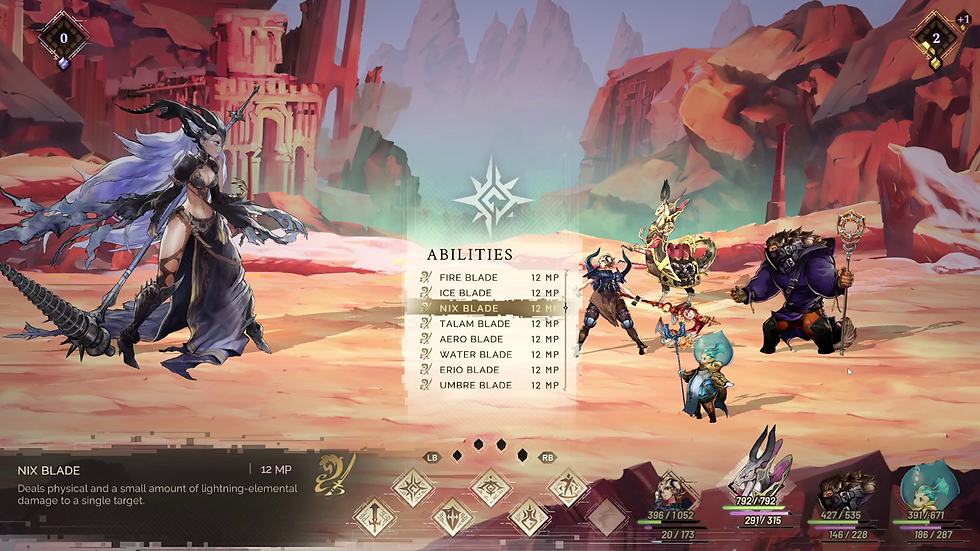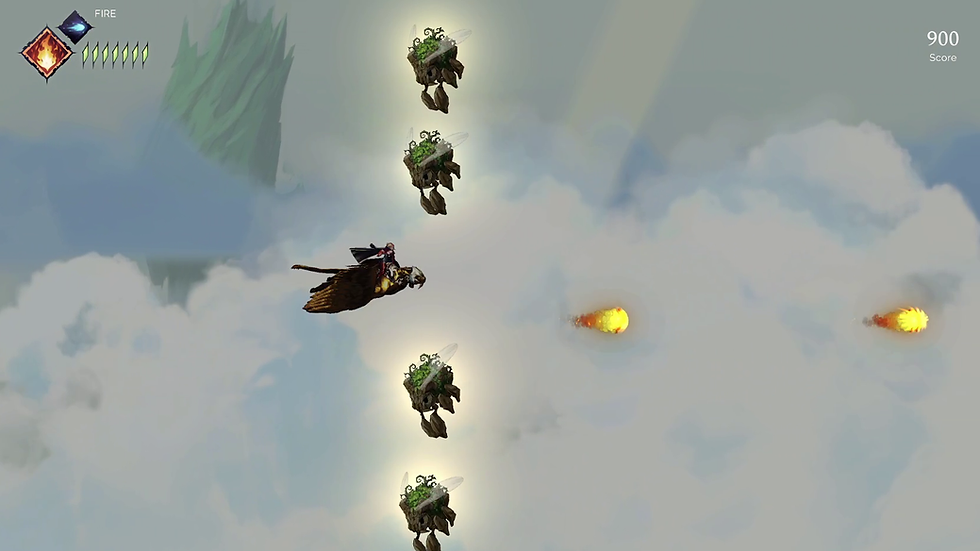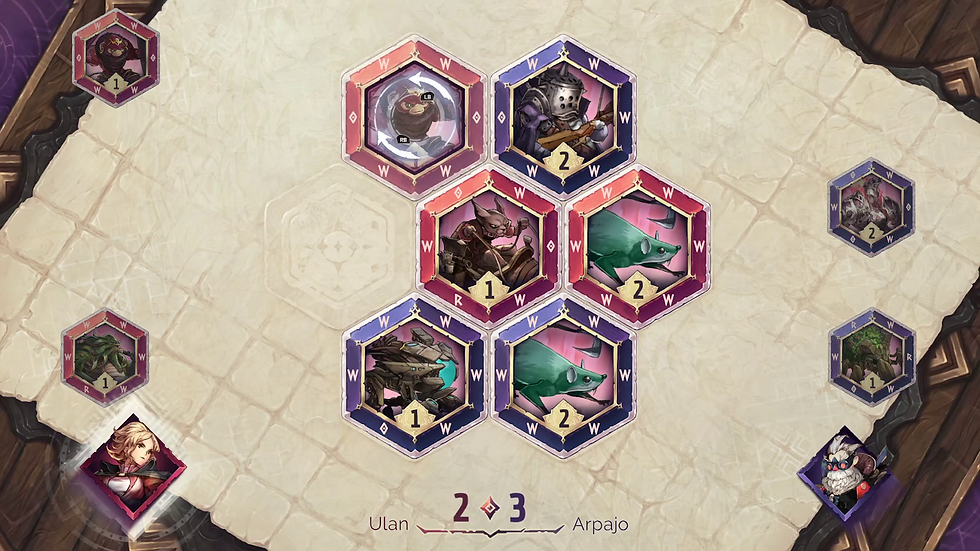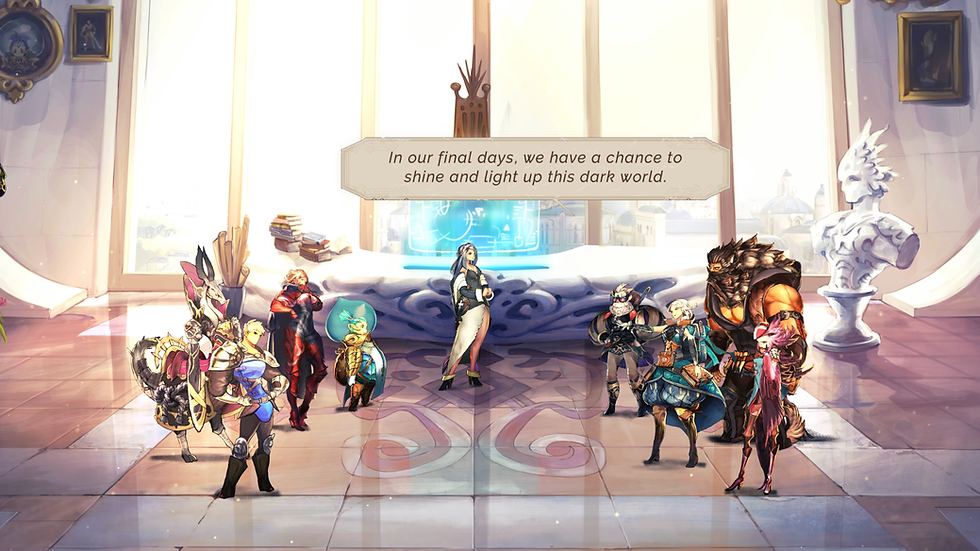Japanese role-playing games are ostensibly the way I got into gaming. As a kid, I watched my brother as he helped a ragtag group of self-proclaimed "eco-terrorists" fight back against an evil corporation, and was introduced to the incredible storytelling potential of video games.
Growing up, JRPGs were the way I made friends and related to some of my family. They represented my first steps into creative writing, as I spent my free writing time in class writing Final Fantasy VIII fan fiction.
I've loved seeing the resurgence of JRPGs — both in popularity and quality — over the last decade. So when I played brand-new indie JRPG, Astria Ascending, I found myself teleported to my youth and the JRPGs of the 90s... for better or worse.

Just the Facts |
Developer: Artisan Studios |
Publisher: Dear Villagers |
Platform(s): Xbox Series X and Series S, PC*, Nintendo Switch, PlayStation 5 *platform reviewed on |
Price: $24.99 |
Release Date: Sept. 30, 2021 |
Key provided by Tinsley PR. |
Fresh off their release in the wildly popular Hyperdimension Neptunia universe, Artisan Studios was well-equipped to tackle a wholly original game.
The studio of just around 20 developers gathered some major help in the form of a few JRPG legends. Kazushige Nojima (Final Fantasy VII, Final Fantasy X) provided the world and story, Hitoshi Sakimoto (Final Fantasy XII) provided the soundtrack, and the team at CyDesignation led by Akihiko Yoshida and Hideo Minaba (Final Fantasy XIV) contributed the game's art and character design.
In Astria Ascending, the world is protected by eight demi-gods. Chosen amongst the world's five distinct races and bestowed with incredible power, these eight fight back against monsters known as Noise and maintain Harmony, the force that regulates the world and its people. There's a catch to being chosen, though. These few are plucked out of their lives and given only three years to serve the world before they reach Transcendence and die.

Unlike many other JRPGs, Astria Ascending has its core cast fully populated right from the start. Instead of finding or recruiting a team of heroes, this game's heroes have been serving the world for years.
Ulan, Alek, Alassia, and Arpajo are Meyro, the fairly bland human analog. Eko is Peyska, an underestimated underwater race who exist on land through a bubble of water around their heads. Dagmar is Arktan, a race of fierce cat-people with strict racial barriers. Kaydin is Awisi, a thin bird-like race that lives high above everyone. And Kress is Zeft, a race of grand lizard people with a heavily structured and sophisticated society.
With just two months left until their transcendence, this oddball "chosen family" is drawn into a conflict with a collection of people who have begun to reject Harmony, advocating for chaos and "Dissonance" instead. Family drama, political drama, gods, and monsters. It's all there.
Familiarity can be good, but Astria's one-dimensional story is one of the biggest disappointments of the journey for me.
It's very basic good vs evil with all the tropes and baggage that high fantasy brings with it. The world that Nojima built (a reworking of a failed mobile project known as Zodiac: Orcanon Odyssey) is deeply fascinating with its layered races and cultures. It's brought to life beautifully by the team. But I wish it was explored in a more satisfying way. Many RPGs can get too lore-heavy, but here I found myself craving just a bit more background detail to make the world feel real.
Astria Ascending is a perfectly good JRPG that is familiar and traditional in a way that is both refreshing and frustrating.
When a world fails to sell me, I look to the characters to help pull me in. And sadly, even with the unique take of having its full cast from the outset, the characters are a disappointment as well. For example, despite having worked together for over two years in high intensity world-saving situations, these characters seemingly know nothing about each other's lives.
There is little sense that these people have shared anything about themselves or their lives in the years before the story began. Thanks to some strange dialogue writing, unexplained magic nonsense, and a general lack of genuine connection between characters, the game never really sold me on these bonds.
On top of that, there's a disappointingly hefty spotlight on the game's human-adjacent race. Four of the eight demi-gods including the leader of the group are Meyro, along with much of the city center's population, and seemingly even the world's Goddess. While each race gets a brief moment in the sun, a deeper exploration of the more interesting and fantastical races could have helped this game stand apart. They could have also done away with the inter-group racism that Eko faces as the "wimpy Peyska." Fantasy racism is played out.
There are still a handful of impactful moments throughout the story, usually having to do with issues of identity (racially or otherwise) and family. But on the whole, the story stays painfully familiar and traditional. Even when it felt like the game could be setting up for a refreshing twist, I'd be let down.

With JRPGs, a good story can often compensate for even the most painful gameplay systems, making some of the most boring and frustrating gaming experiences worthwhile thanks to a coherent and interesting story. Astria Ascending does a little flip-flop and finds ways to use its gameplay to make up for its lacking story.
Astria's turn-based combat system is wildly fun. Using the classic Rock-Paper-Scissors gameplay of finding an enemy's weaknesses with elemental magic attacks, Artisan puts their own twist on things with the Focus Point system.
Focus Points are accumulated when you nail an enemy's weakness and are taken away when you hit them with what they're strong against. You may also spend a character's turn to gain a Focus Point. They can then be spent to strengthen any number of a character's actions.
It all amounts to a system that strengthens your best characters in combat and allows characters that may otherwise be useless to contribute to the fight in a meaningful way. With eight unique characters to juggle (only four in combat), elemental weaknesses to consider, and Focus Points to intensify your strongest attacks, combat scenarios can become a fun "how quickly can I wipe out this screen?" puzzle.
There are some modernizations I wish were present: First, a turn order indicator to make sense of the game's logic with haste and slow abilities, and second, a system that recognizes which weaknesses you've already identified in enemies.
While the combat is fun, it grows repetitive, especially amidst some of the late-game difficulty spikes and overall pacing issues.
Your journey starts out straightforward, taking you from the game's hub, Harmonia Tower, to a new overworld location, then through a temple, and back to the tower in the end. It's another failure of the story that this loop is also narratively identical in the game's first several chapters.
Eventually, you're allowed to tackle a number of open objectives on your own, where suddenly enemies are anywhere from 10-20 levels stronger than you. Each new section that follows introduces jumps in difficulty similar to this. This demands grinding for levels, which is a painful but necessary evil that I wish JRPGs could be rid of. Modern JRPGs have found a way to tamp down the issue or at least make it clear where you need to be level-wise for particular areas, neither of which Astria accomplishes.
The suddenness of these higher difficulty zones caught me completely off guard, and one boss encounter even had me loading an older save and cranking the difficulty down (which is a welcome accessibility option that most JRPGs are lacking) just to be able to progress.

Related to combat, those who enjoy min-maxing their characters will have a ton to enjoy here. We've got a job system with several layers (base job, main job, sub job, support job), skill trees associated with each job, each with tons of abilities to unlock. Each character comes set with an obvious path, but you can truly mold them however you'd like through the nodes you select. It can be intimidating at the outset, as you have to manage dozens of different skill trees and job selection for eight characters without really knowing where you want to take them, but it does feel fulfilling to build a solid character by the end.
One of the core things I look for in an RPG are the ways they break up the combat with other unique systems. For example, genre-leader Persona 5's social and school-based shenanigans in between long dungeons. Astria may not reach those top-notch standards, but it does offer interesting diversions from casting spells and slashing Noise amid its 50+ gameplay hours.
Outside of combat, you explore and interact with the world through rudimentary 2D side-scrolling platforming. It's far less engaging when in towns and some simpler overworld areas, but it shines in the game's dungeons. Littered with engaging puzzle sections that make use of the game's elemental magic, you'll equip Ulan (the leader of the crew who you control in these sections) with a ring that uses these spells to interact with the world.
Simple block pushing and "find the lever or button" puzzles will slowly grow into more complex challenges as you go. Highlights from the game's 25 dungeons are the Gemini Temple with its clever wind-based puzzles and the twisty and spooky Taurus Temple that features some dangerous platforming.
There are even a few unexpected minigames that, while a bit thinner than I'd like, were some of the high points of my time with the game. As pictured above, there's a classic horizontal shoot-em-up minigame that comes up in a few of your travels. It's wholly unnecessary and basic, but I found myself endeared to it and sought them out by the game's end.
On top of that, there's J-Ster, Orcanon's card game of choice that nearly everyone in the world is ready to play. Through an in-world interaction, you learn that this is essentially Artisan Studios' take on well-regarded Final Fantasy VIII's Triple Triad. And I LOVE Triple Triad. It isn't the most fun to engage with early on, as game tokens are hard to come by until they're given out as rewards for quests later in the game, but I did lose a few hours grinding it out when I had a solid deck.

Even with the story frustrations and a few stretches of tedium, I found a lot of enjoyment in actually playing Astria Ascending. It took me back to my childhood, including the game's look and feel. With a soaring and epic soundtrack from Sakimoto and the amazing hand-drawn art from CyDesignation, I was reminded of the beautiful art design of some of my favorite PS1 JRPGs. Some may call the art design Vanillaware-esque, but if you look at some of the concept art of the classic works these designers created, you'll realize that this is just the culmination of their decades in the industry.
It's a beautiful celebration of the team's artistry and is without a doubt the best bit of the experience.
I was disappointed to see the over-sexualized character design present here, an undesirable remnant of some classic JRPGs. There's full-on jiggling where there doesn't need to be, plus strong and menacing male designs while the same race's female form is all thick thighs and skimpy outfits (I'm looking at you, Arktan). If you're able to look past it, the quality of the design work is readily apparent.
Overall, Astria Ascending is a perfectly good JRPG that is familiar and traditional in a way that is both refreshing and frustrating. What it does differently from others in its class (fun and unique temple puzzles, amazing quality art assets) are enough to help it rise from the ashes of its storytelling faults. Major difficulty spikes and repetitive encounters hold it back from greatness and may make this a skip for some, but the adventure will speak to many fans of classic JRPGs.
video games are good and Astria Ascending is . . . GOOD. (7/10)
+ incredibly fun and unique puzzle platforming sections for the genre, beautiful art and music
- while the combat system is serviceable, difficulty spikes and necessary grinding sections make it incredibly tedious. story is a little one dimensional

Thanks for reading this video games are good review. If you're interested in learning more about our review rubric, click here! Wanna join our Discord, where you can discuss reviews and get early views at upcoming articles? Click here! Thank you for supporting video games are good.


Comentários